| |
Abstract
Objectives: This study aims to investigate the types and indications of amulets, bands and traditional applications among pediatric emergencies and neonatal admissions into the Federal Medical Centre, Bida, Nigeria.
Methods: This was a cross-sectional study conducted between January and July, 2008. Children admitted into the emergency and neonatal units of the institution with traditional applications were recruited. Information on demography, time the application was introduced, the reason, cost implication and belief about the efficacy were obtained using a semi-structured questionnaire. Socio-Economic Class was defined using the Oyedeji Classification.
Results: The study was based at Federal Medical Centre, Bida and consisted of 666 children admitted into the hospital via the Emergency pediatric and the Neonatal Unit, with a seven-month period prevalence of 11.4% (76 patients). Of the 76 cases screened for the use traditional applications, only 64 (84.2%) were recruited, the remaining did not agree to participate in the study. The mean age was 493.1±528.5 days. The study group included 37 males and 27 females (sex ratio 1.4:1) aged 11 days to 2920 days. The applications used included neck band (54.7%), ankle band (15.6%) and head paste (15.6%). Reasons for the applications included prevention of childhood illnesses (17.2%), sutures closure (15.6%), as well as warding off evil spirits and convulsions (12.5%). The socio-economic classification was I (1.6%), II (7.8%), III (15.6%), IV (45.3%), and V (29.7%). Sixty (93.0%) parents believed the applications cannot be used with conventional medicine, while 53.1% of the participants, obtained them free of charge.
Conclusion: The use of traditional applications, often for preventive purposes, is common among pediatric patients, especially of low socio-economic classifications. The majority of users considered them incompatible with simultaneous conventional medical care. This has adverse implications for time to presentation for conventional care and treatment outcomes. Promotive and preventive healthcare interventions are needed to reverse this trend. Future broad-based research is warranted.
Keywords: Traditional applications; Hospitalized children; Tertiary centre; Nigeria.
Introduction
Culture is a whole complex of traditional behavior which has been developed by the human race and is successively learned by each generation.1-3 It encompasses all forms of traditional behavior which are characteristic of a given society, race, or geographic area over a period of time.2,3 An amulet is defined by the Oxford Advanced Learner’s English Dictionary as: "A piece of jewellery that some people wear because they think it protects them from bad luck, diseases, etc."4 The term Amulet is derived from the Latin word amuletum, which means a lucky jewelry or object.5 Several forms exist in several communities in the past and present as part of their culture. Culture has been known to impact significantly on the health of people either positively or negatively. It reflects in people's belief, customs, norms and values. Certain characteristics such as educational levels, financial status, and experiences amongst others come to play in determining cultural trends.2 Culture affects the health seeking habits of human populace. The pediatric age group is the most affected since children lack decisional autonomy.
In the community where this study was conducted, a woman may not be willing to take an ailing child to the hospital just because she has not been able to inform the husband, and in some cases, if she was able to inform the husband and he felt otherwise, then the man’s decision is final. The use of traditional applications is practiced in several cultures. Globalization has however dissociated culture from a particular geographic area, race and religion. Some cultural practices become extinct with time, while some persist and even spread to other parts of the world.1 There is increasing need for standard medical practitioners to understand the cultural practices of the populations they serve in order to better understand the diseases and appropriately counsel and manage the patients.2 In response to this research need, this cross-sectional study was conducted to investigate traditional applications among emergency and neonatal pediatric admissions at FMCB to identify the types, indications, perceived efficacy and cost. The findings would assist healthcare planners and providers in formulating promotive and preventive pediatric healthcare strategies.
Methods
The study was based at the Federal Medical Centre, Bida; the only tertiary Medical institution in Niger state, North-Central Nigeria serving the people of Bida who are mainly Nupe ethnic. It also serves as a referral centre for the adjoining cities such as Mokwa, Minna, suleja, Keffi and Abuja. The projected population of Bida is 1,919,745 (based on 2006 census),6 and a cross-sectional study was conducted over a seven-month period between January and July, 2008.
The study instrument was a structured pre-tested researcher-administered close-ended questionnaire. Ethical approval was granted by the Ethics and Research Committee of the institution. Inclusion criteria included all patients admitted with any form of superficial applications. Exclusion criteria included patients whose parents or care givers declined participation. The socio-economic class was derived using the Oyedeji socio-Economic Classification, (Table 1),7 in which the parents’ occupation and educational status are graded on a scale of 1-5 (from highly skilled and highly educated being 1 and unemployed and uneducated being 5).
The information gathered also included age, gender, type of traditional application, date of application, outcome, reason(s) for the application, belief in the compatibility with conventional care, cost of the application and the parental perception of the efficacy of the application as shown in the questionnaire. All patients were given standard care based on their primary ailments. Counselling was provided as necessary. Data were entered into and analyzed using the Statistical SPSS version 15, to yield frequencies, percentages and proportions. Inter-group comparisons were performed using the chi-square test. A value of p<0.05 was considered statistically significant.
Results
A total of 666 children comprising 374 males and 292 females (sex ratio 1.3:1) were admitted into the hospital via the Emergency pediatric unit and the Neonatal Unit of FMC, Bida during the study period. Of these, 76 (11.4%) had at least one form of traditional application. However, 12 (15.8%) of the parents/ care givers did not agree to provide further information on the applications thus their children were excluded from the study. The remaining 64 (84.2%) were recruited. There were 37 males and 27 females (sex ratio 1.4:1) with an age range of 11 days to 2920 days (8 years). The distribution was skewed (1.59), and the median age of the participants was 345.0 days. The distribution of the participants by ethnic group showed that 55 (85.9%) were Nupe, 4 (6.3%) were Yoruba, 2 (3.1%) were Hausa, 1 (1.6%) each from Ibo, Fulani and Gwari. A neck band was seen in 35 (54.7%) cases, ankle band was seen in 10 (15.6%) cases and paste on the head in 10 (15.6%), while 9 (14.1%) patients had waist or wrist bands. (Figs. 1-4)
These traditional applications were applied within the first week of life in 8 (12.5%) of the children, while in 22 cases (34.4%) the application was applied before the first month of life, and in 23 patients (35.9%) by the first year. The remaining 11 (17.2%) cases were applied after the first year. The socio-economic classification was I in 1 (1.6%) patient, II in 5 (7.8%) cases, III in 10 (15.6%) cases, IV in 29 (45.3%) cases, and V in 19 (29.7%) cases. The functions of the applications according to the parents or care givers included; prevention of childhood illnesses (17.2%), closure of sutures (15.6%), to ward off evil spirits and to prevent convulsions (12.5%) each, to prevent and combat skin rashes (10.9%), for growth enhancement (7.8%) and enhancement of intelligence (3.1%). (Table 2)
Table 1: Socio-economic classification scheme by oyedeji.7
|
For Occupation
|
|
Class
|
Occupation
|
|
I
|
Senior Public Servants, Professionals, Managers, large scale traders, businessmen and contractors.
|
|
II
|
Intermediate grade public servants and senior school teachers.
|
|
III
|
Junior school teachers, professional drivers, artisans
|
|
IV
|
Petty traders, laborers, messengers
|
|
V
|
Unemployed, full-time housewife, students and Subsistence farmers.
|
|
For Education
|
|
Class
|
Education
|
|
I
|
University graduates or equivalents
|
|
II
|
School certificate holders ordinary level (GCE) who also had teaching or other professional training.
|
|
III
|
School certificate or grade II teachers certificate holders or equivalents.
|
|
IV
|
Modern three and primary six certificate holders.
|
|
V
|
Those who could either just reads and write or were illiterate.
|
The application was introduced by the parents in 41 (64.1%) cases, as a family tradition by the grand parents in 16 (25.0%) cases, or by neighbors or family friends in 7 (10.9%) cases. Sixty (93.0%) of the parents or care givers believed the application cannot be used simultaneously with conventional medicine, 21 (32.8%) believed it had not worked, while 32 (50%) felt that it had worked. No money was spent in 34 (53.1%) cases, less than 150 naira (1 United states Dollars) was used in 8 (25%) cases, less than 500 naira (3.3 USD) was used in 12 (18.8%) cases, while more than 500 naira (3.3 USD) but less than 1,000 naira (6.6 USD) was used in 2 (3.2%) cases. The cost was unspecified in 8 (12.5%) cases. Forty four (68.8%) of the study participants were managed and discharged, 9 (14.1%) left against medical advice, 2 (3.1%) absconded and 9 (14.1%) died.
Table 2: Functions of Traditional Applications.
|
Function
|
Frequency
|
Percentage
|
|
Prevention of childhood illnesses
|
11
|
17.1
|
|
Closure of sutures
|
10
|
15.6
|
|
Ward off evil spirit
|
8
|
12.5
|
|
Treatment of sunken fontanelle
|
8
|
12.5
|
|
Treatment of skin rashes
|
7
|
10.9
|
|
Treatment of "teething problems"
|
6
|
9.4
|
|
Growth enhancement
|
5
|
7.8
|
|
Enhancement of intelligence
|
2
|
3.1
|
|
Treatment of excessive crying
|
2
|
3.1
|
|
Unspecified
|
5
|
7.8
|
|
Total
|
64
|
100
|
Discussion
This study found a hospital seven-month period prevalence of 11.4% for the use of traditional applications which, to the best of the authors’ knowledge is the first documented hospital based prevalence of the use of traditional applications. Extensive literature search only revealed that it is a common practice in most parts of the world. This calls for replication of similar studies in several regions of the world to document and describe the exact prevalence in a more scientific manner so as to appreciate the actual magnitude of the problem it poses to the health of children in terms of health seeking behavior of parents or care givers of such children.
Though the study was carried out among the pediatric age group; most of the participants were infants with the median age being just below one year of life. This is probably due to the reported higher vulnerability of younger children to harmful traditional health practices as they lack decisional autonomy in cases or events that can affect them positively or negatively.2 The skewed distribution of the participants towards the infant age group is another confirmation of this fact.
The preponderance of the Nupe tribe is due to the location of the study centre.7,8 Studies have shown the diverse use of such applications in Africa and beyond. The Pitt Rivers Museum is said to have almost 6,000 amulets and charms in its collections which were collected from all over the world including England.5 Most are made from similar structures or raw materials such as leather, fur, cowrie, bone, bark of tree, coin, concoctions paste and threads of various thickness.5 The forms in the study were made of one or a combination of the above material as shown in Figs. 1-6.
Poor socio-economic status appears to be a major factor encouraging the use of these applications as majority of the families belonged to the lower socioeconomic strata. The findings seem to suggest the need to target people of low socio-economic status during promotive and preventive health interventions aimed at combating the use of traditional applications. This is also corroborated by the fact that in over half of the cases, there was no direct financial implication on most of the parents. This is in agreement with earlier reports which have suggested that the thriving nature of some harmful cultural practices were based on poverty and ignorance.2,7,8
The study showed that one out of every eight of the children had the band or amulet applied during the perinatal period; a period when extreme caution is required in the handling of babies with a view to reducing the risk of transmission of infection. Also, some of these bands were tight fitting posing risk of strangulation of the babies, (Fig. 1). Some accessories such as fur and leather can easily be a focus of infection or allergies for babies (Figs. 2-3).9 When this occurs, it is capable of increasing childhood morbidity and mortality, making it more difficult to achieve the Millennium Development Goal of reducing child mortality.
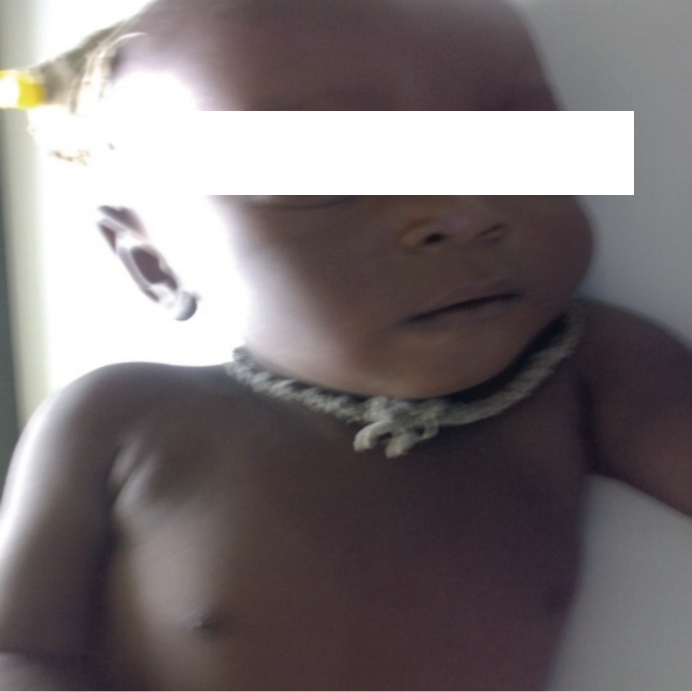
Figure 1: Tight Neck Band.
The parents believed that these applications have some supernatural powers to prevent children from falling ill; which apparently was not, hence their children were hospitalized, and some believed such applications aide the closure of fontanells, which is a normal developmental issue. The belief that it prevents and cures skin rashes could also not be substantiated. A third of the parents resorted to conventional medical care when they realized that the applications had not worked effectively, while the others still felt that the applications had worked to some extent. However, seeking medical attention was common despite the differences in appreciation of the efficacy. This is not surprising because most of the applications were applied either by the grand parents as a family tradition or by the parents who probably lack modern education, and are highly conservative as seen in most parts of Nigeria and Africa in general. The high proportion of patients that left against medical advice (LAMA) may be due to the insistent of the parents or care givers after the stabilization of the children, especially by those that still held the belief that such treatment are not compatible with the amulets or other applications being worn on the children.
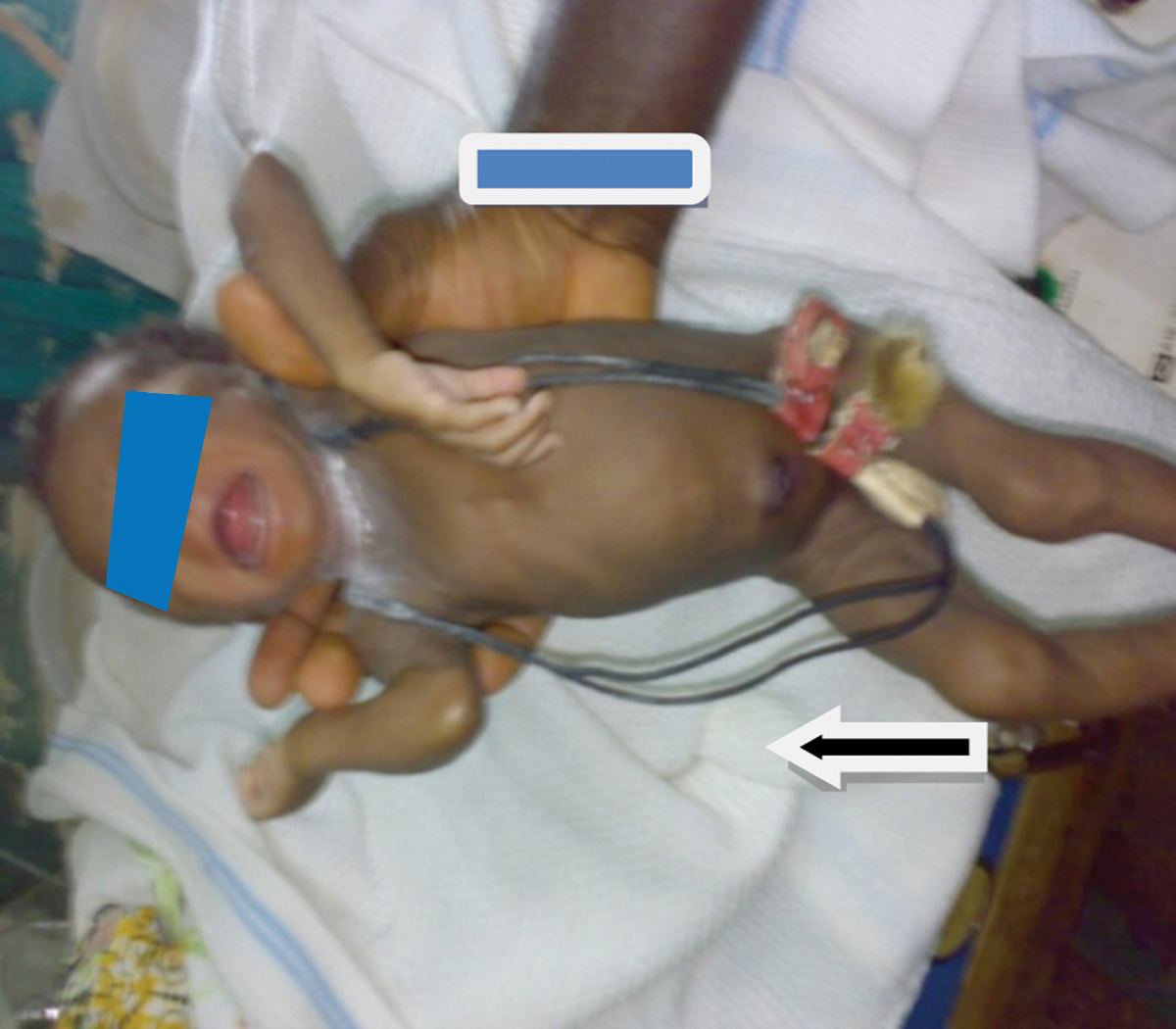
Figure 2: Loose neck band with cowrie, leather and animal fur assessories.
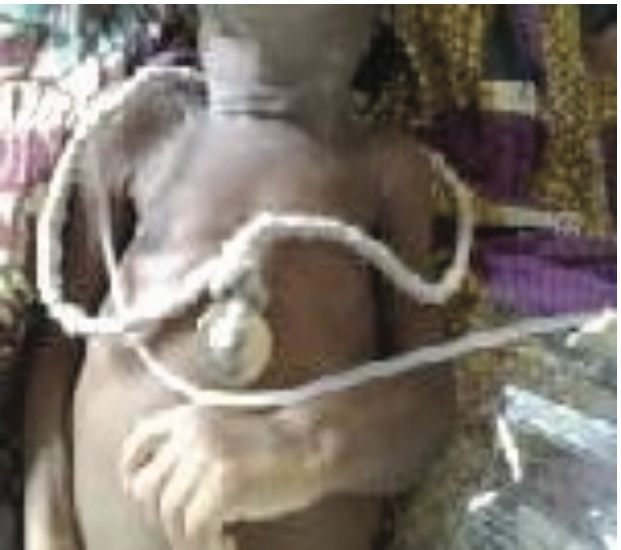
Figure 3: Loose neck band with a coin pendant in a morbidly ill neonate.
Unlike what is obtainable in developed countries where scientific evidence for or against traditional practices are thoroughly investigated,10-13 in Nigeria, there is paucity of published studies on the subject matter despite the fact that it is generally observed to be common. For instance, recently, scientists in Canada and some African countries are collaborating with traditional healers in a number of ways to explore the advantages of people’s socio-cultural beliefs.11
Some of the consequences of the use of traditional applications include; late presentation, foci of infection, allergenicity, strangulation, initial sense of security on the part of the patrons because of the belief in the magical powers of such applications. This then allows for delays in presentation for conventional medical care and ultimately increases the risk of morbidity and mortality. In the present study, some of the children were presented morbidly ill with a large neck band, (Fig. 3). The baby was among the mortalities recorded in the present study.
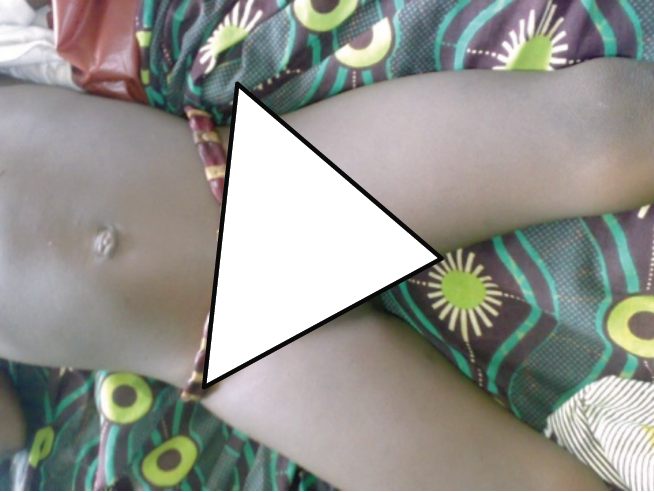
Figure 4: Waist band.
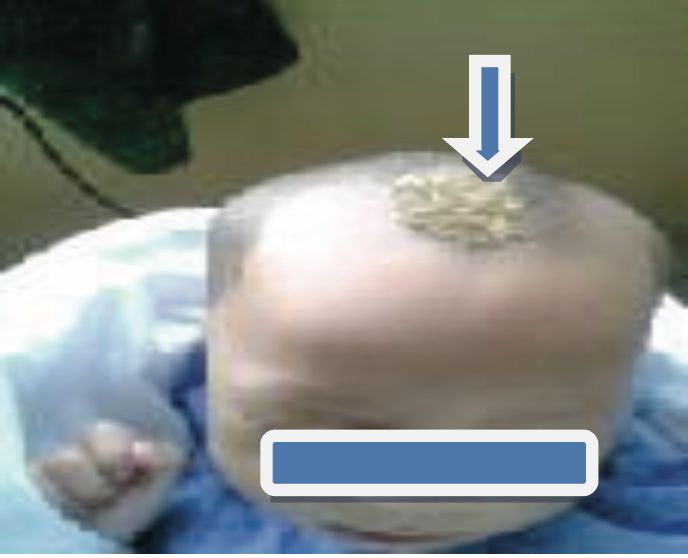
Figure 5: Head paste.
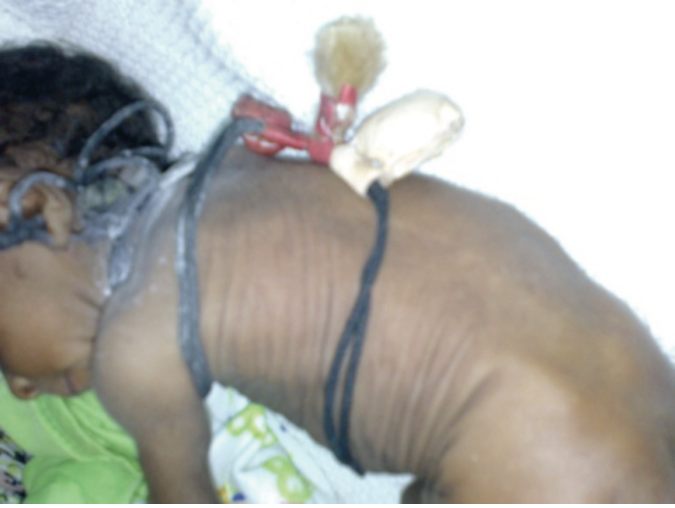
Figure 6: Twisted neck band.
The limitations of this study include; the length of study period (seven months) which may not have allowed for better appreciation of any seasonal variations in the use of traditional applications, also the hospital-based nature of the study makes it difficult to generalize on the community.
Conclusion
In summary, the use of traditional applications among hospitalized children in Federal Medical Centre, Bida is high, particularly among the low socioeconomic class. The reasons for the use of these applications include; prevention of childhood illnesses, prevention and treatment of skin rashes, and treatment of convulsion and "warding off evil", as well as enhancement of intelligence, and closure of the fontanelles. The low socio-economic community (poverty and illiteracy) is highly predisposed to resort to such applications. Hence the consequences include delayed presentation for conventional medical care and increased morbidity and mortality.
If allowed to continue unchecked, it will make the dream of achieving the fourth Millennium development goal a very difficult reality. Hence, there is need for continuous health education and sensitizing public awareness to reduce the level of ignorance about the courses and causes of common childhood diseases so as to reduce the risks from such non-therapeutic practices. It is hereby recommended that a similar study be duplicated in as many parts of the world as possible within communities and within hospitals to appreciate the regional, national or institutional peculiarities as it concerns the use of traditional applications in the present dispensation with a view to halting the harmful practices through appropriate health education interventions. The authors recommend the duplication of similar hospital-and community-based studies in other parts of the world to explore variations between institutions, nations, and regions.
Acknowledgements
We thank the management of Federal Medical Centre for the approval given for the study. We also appreciate the parents/ caregivers of the children that participated in the study. No funding was received for this work.
References
1. Boyd R, Richerson PJ. Culture and the Evolutionary Process. University of Chicago Press; 1988: 1-15.
2. Rumati V. Cultural Aspects of Common Childhood Diseases In: Stanfield P, Brueton M, Chan M, Parkin M, Waterson T eds. Diseases of the Children in the Subtropics and Tropics. Butler and Tanners, London: 1991;14-25.
3. Birukou A, Blanzieri E, Giorgini P, Giunchiglia F. A formal definition of culture. Technical Report on Modeling Intercultural Collaboration and Negotiation (MICON) at International Joint Conference on Artificial Intelligence. Prasadena, California, USA, July 11-17, 2009.
4. Wehmeier S, Florio J, Ashby M, Lea D, eds. Oxford Advanced Learner’s English Dictionary 6th Edition pg 35.
5. Discover amulets and charms. Available at www.prm.ox.ac.uk/introductoryguides Date accessed 12/12/2010: 1-16.
6. Bida NS. Available at www.mapofworld.com/nigeria/cities/bida.html, Date accessed, 17/12/2010: 1-2.
7. Oyedeji GA. Socioeconomic and cultural background of hospitalized children in Ilesa. Niger J Paediatr 1985;12:111-117.
8. Yahaya MK. The Nupe People of Nigeria. Stud. Tribes Tribals 2003;1(2):95-110.
9. Tallur SS, Kasturi AV, Nadgir SD, Krishna BV. Clinico-bacteriological study of neonatal septicemia in Hubli. Indian J Pediatr 2000 Mar;67(3):169-174.
10. McCubbin HI, Thompson EA, Thompson AI, McCubbin MA, Kaston AJ. Culture, ethnicity, and the family: critical factors in childhood chronic illnesses and disabilities. Pediatrics 1993 May;91(5 Pt 2):1063-1070.
11. Courtright P, Chirambo M, Lewallen S, Chana H, Kanjaloti S. Neonatal conjunctivitis and other childhood eye diseases In: Collaboration with African Traditional Healers for the Prevention of Blindness. World Scientific Publishing Co. Pte. Ltd. Singapore; 2000; 26-28.
12. Kleinman A, Eisenberg L, Good B. Culture, illness, and care: clinical lessons from anthropologic and cross-cultural research. Ann Intern Med 1978 Feb;88(2):251-258.
13. al-Majed SA, Harakati MS. The effect of henna paste on oxygen saturation reading obtained by pulse oximetry. Trop Geogr Med 1994;46(1):38-39.
|
|